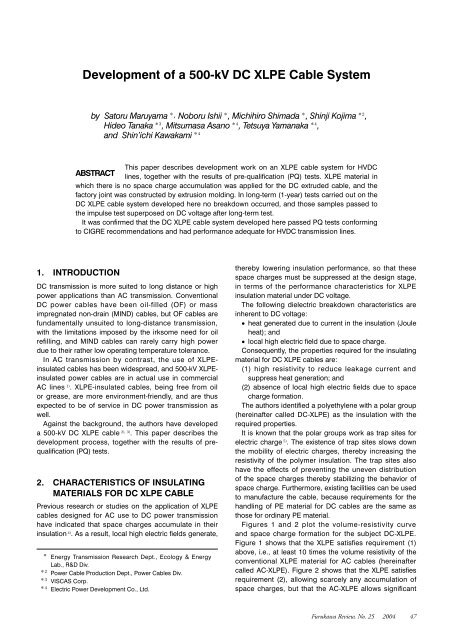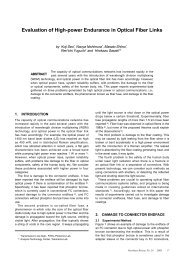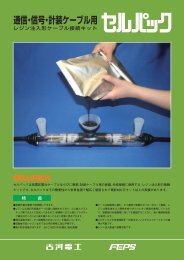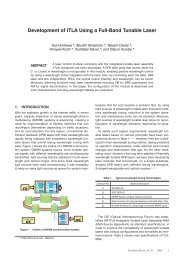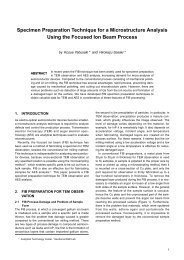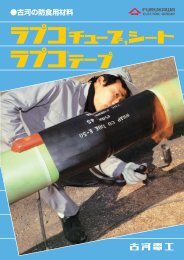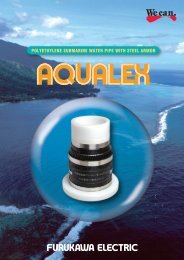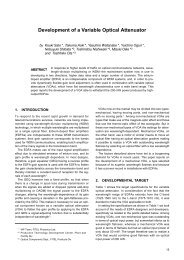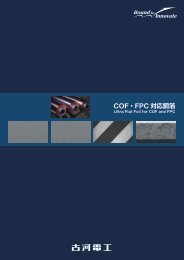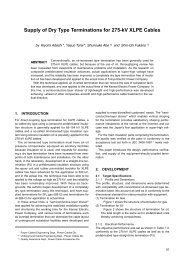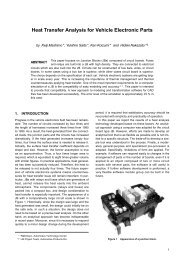Development of a 500-kV DC XLPE Cable System
Development of a 500-kV DC XLPE Cable System
Development of a 500-kV DC XLPE Cable System
Create successful ePaper yourself
Turn your PDF publications into a flip-book with our unique Google optimized e-Paper software.
<strong>Development</strong> <strong>of</strong> a <strong>500</strong>-<strong>kV</strong> <strong>DC</strong> <strong>XLPE</strong> <strong>Cable</strong> <strong>System</strong><br />
by Satoru Maruyama *, Noboru Ishii *, Michihiro Shimada *, Shinji Kojima * 2 ,<br />
Hideo Tanaka * 3 , Mitsumasa Asano * 4 , Tetsuya Yamanaka * 4 ,<br />
and Shin’ichi Kawakami * 4<br />
This paper describes development work on an <strong>XLPE</strong> cable system for HV<strong>DC</strong><br />
ABSTRACT lines, together with the results <strong>of</strong> pre-qualification (PQ) tests. <strong>XLPE</strong> material in<br />
which there is no space charge accumulation was applied for the <strong>DC</strong> extruded cable, and the<br />
factory joint was constructed by extrusion molding. In long-term (1-year) tests carried out on the<br />
<strong>DC</strong> <strong>XLPE</strong> cable system developed here no breakdown occurred, and those samples passed to<br />
the impulse test superposed on <strong>DC</strong> voltage after long-term test.<br />
It was confirmed that the <strong>DC</strong> <strong>XLPE</strong> cable system developed here passed PQ tests conforming<br />
to CIGRE recommendations and had performance adequate for HV<strong>DC</strong> transmission lines.<br />
1. INTRODUCTION<br />
<strong>DC</strong> transmission is more suited to long distance or high<br />
power applications than AC transmission. Conventional<br />
<strong>DC</strong> power cables have been oil-filled (OF) or mass<br />
impregnated non-drain (MIND) cables, but OF cables are<br />
fundamentally unsuited to long-distance transmission,<br />
with the limitations imposed by the irksome need for oil<br />
refilling, and MIND cables can rarely carry high power<br />
due to their rather low operating temperature tolerance.<br />
In AC transmission by contrast, the use <strong>of</strong> <strong>XLPE</strong>insulated<br />
cables has been widespread, and <strong>500</strong>-<strong>kV</strong> <strong>XLPE</strong>insulated<br />
power cables are in actual use in commercial<br />
AC lines 1) . <strong>XLPE</strong>-insulated cables, being free from oil<br />
or grease, are more environment-friendly, and are thus<br />
expected to be <strong>of</strong> service in <strong>DC</strong> power transmission as<br />
well.<br />
Against the background, the authors have developed<br />
a <strong>500</strong>-<strong>kV</strong> <strong>DC</strong> <strong>XLPE</strong> cable 2), 3) . This paper describes the<br />
development process, together with the results <strong>of</strong> prequalification<br />
(PQ) tests.<br />
2. CHARACTERISTICS OF INSULATING<br />
MATERIALS FOR <strong>DC</strong> <strong>XLPE</strong> CABLE<br />
Previous research or studies on the application <strong>of</strong> <strong>XLPE</strong><br />
cables designed for AC use to <strong>DC</strong> power transmission<br />
have indicated that space charges accumulate in their<br />
insulation 4) . As a result, local high electric fields generate,<br />
* Energy Transmission Research Dept., Ecology & Energy<br />
Lab., R&D Div.<br />
* 2 Power <strong>Cable</strong> Production Dept., Power <strong>Cable</strong>s Div.<br />
* 3 VISCAS Corp.<br />
* 4 Electric Power <strong>Development</strong> Co., Ltd.<br />
thereby lowering insulation performance, so that these<br />
space charges must be suppressed at the design stage,<br />
in terms <strong>of</strong> the performance characteristics for <strong>XLPE</strong><br />
insulation material under <strong>DC</strong> voltage.<br />
The following dielectric breakdown characteristics are<br />
inherent to <strong>DC</strong> voltage:<br />
• heat generated due to current in the insulation (Joule<br />
heat); and<br />
• local high electric field due to space charge.<br />
Consequently, the properties required for the insulating<br />
material for <strong>DC</strong> <strong>XLPE</strong> cables are:<br />
(1) high resistivity to reduce leakage current and<br />
suppress heat generation; and<br />
(2) absence <strong>of</strong> local high electric fields due to space<br />
charge formation.<br />
The authors identified a polyethylene with a polar group<br />
(hereinafter called <strong>DC</strong>-<strong>XLPE</strong>) as the insulation with the<br />
required properties.<br />
It is known that the polar groups work as trap sites for<br />
electric charge 5) . The existence <strong>of</strong> trap sites slows down<br />
the mobility <strong>of</strong> electric charges, thereby increasing the<br />
resistivity <strong>of</strong> the polymer insulation. The trap sites also<br />
have the effects <strong>of</strong> preventing the uneven distribution<br />
<strong>of</strong> the space charges thereby stabilizing the behavior <strong>of</strong><br />
space charge. Furthermore, existing facilities can be used<br />
to manufacture the cable, because requirements for the<br />
handling <strong>of</strong> PE material for <strong>DC</strong> cables are the same as<br />
those for ordinary PE material.<br />
Figures 1 and 2 plot the volume-resistivity curve<br />
and space charge formation for the subject <strong>DC</strong>-<strong>XLPE</strong>.<br />
Figure 1 shows that the <strong>XLPE</strong> satisfies requirement (1)<br />
above, i.e., at least 10 times the volume resistivity <strong>of</strong> the<br />
conventional <strong>XLPE</strong> material for AC cables (hereinafter<br />
called AC-<strong>XLPE</strong>). Figure 2 shows that the <strong>XLPE</strong> satisfies<br />
requirement (2), allowing scarcely any accumulation <strong>of</strong><br />
space charges, but that the AC-<strong>XLPE</strong> allows significant<br />
Furukawa Review, No. 25 2004 47
<strong>Development</strong> <strong>of</strong> a <strong>500</strong>-<strong>kV</strong> <strong>DC</strong> <strong>XLPE</strong> <strong>Cable</strong> <strong>System</strong><br />
<br />
<br />
<br />
<br />
<br />
<br />
<br />
<br />
<br />
<br />
<br />
<br />
Figure 1 Volume resistivity <strong>of</strong> <strong>XLPE</strong> materials.<br />
<br />
<br />
<br />
<br />
<br />
Figure 3<br />
<br />
<br />
<br />
<br />
<br />
<br />
<br />
Short term breakdown characteristics <strong>of</strong><br />
model cables.<br />
<br />
<br />
<br />
<br />
<br />
<br />
<br />
<br />
<br />
<br />
<br />
<br />
3.2 Long-term Electrical Properties<br />
Long-term tests were carried out on a model cable using<br />
<strong>DC</strong>-<strong>XLPE</strong> to confirm that the “n” value <strong>of</strong> the inverse<br />
power law for the model cable under <strong>DC</strong> voltage was<br />
15 or higher, and that the model cable had an “n” value<br />
equal to that <strong>of</strong> an ultra high voltage <strong>XLPE</strong> cable 1) .<br />
We were able to obtain satisfactory results from the<br />
model cables in terms <strong>of</strong> both the short-term breakdown<br />
characteristics and long-term characteristic stability <strong>of</strong> the<br />
<strong>DC</strong>-<strong>XLPE</strong> developed here.<br />
Figure 2<br />
<br />
<br />
Space charge characteristics <strong>of</strong> <strong>XLPE</strong> materials.<br />
accumulation <strong>of</strong> space charges in specific regions<br />
close to the inner semiconductive layer. On analysis we<br />
have found that the subject <strong>XLPE</strong> satisfies the electric<br />
insulation requirements for <strong>DC</strong> <strong>XLPE</strong> cable.<br />
3. ELECTRICAL CHARACTERISTICS OF<br />
MODEL CABLES<br />
We examined the dielectric breakdown characteristics<br />
<strong>of</strong> model cables to investigate the subject <strong>DC</strong>-<strong>XLPE</strong><br />
material.<br />
3.1 Breakdown Characteristics<br />
Dielectric breakdown test in the model cables was carried<br />
out under the following conditions.<br />
Test sample:<br />
conductor size: 200 mm 2<br />
insulation thickness: 9 mm<br />
Test temperature: 90°C at conductor (∆T=20°C)<br />
Here, ∆T means the temperature difference between<br />
the conductor and the shielding layer.<br />
Figure 3 plots dielectric breakdown strength for<br />
<strong>DC</strong>-<strong>XLPE</strong> vs. AC-<strong>XLPE</strong>, showing that <strong>DC</strong>-<strong>XLPE</strong> clearly<br />
surpasses AC-<strong>XLPE</strong> in <strong>DC</strong> breakdown strength. Thus the<br />
<strong>DC</strong>-<strong>XLPE</strong> has better characteristics than the AC-<strong>XLPE</strong><br />
from the standpoint <strong>of</strong> short-term operation in <strong>DC</strong><br />
breakdown strength.<br />
3.3 Space Charges<br />
3.3.1 Under low electric field<br />
We investigated the space charge characteristics <strong>of</strong><br />
the model cable in a low electric field equivalent to an<br />
operating field.<br />
A pulsed electroacoustic method 6) was applied to<br />
measure the space charges, where the electric field<br />
distribution was calculated based on the measured space<br />
charge distribution. The test conditions were as follows:<br />
Test sample:<br />
conductor size: 100 mm 2<br />
insulation thickness: 3 mm<br />
Test temperature: 90°C at conductor<br />
Applied electric field: 30 <strong>kV</strong>/mm<br />
Application time: 2,160 h<br />
Figure 4 plots the electric field distribution for a<br />
<strong>DC</strong> <strong>XLPE</strong> cable, while Figure 5 plots the electric field<br />
distribution for an AC <strong>XLPE</strong> cable.<br />
Figure 4 indicates that the <strong>DC</strong> <strong>XLPE</strong> cable incurred<br />
scarcely any accumulation <strong>of</strong> space charges at the<br />
outset <strong>of</strong> voltage application, and the consequent electric<br />
field distribution was determined by the electrostatic<br />
capacitance. Yet, over time, we see a trend toward a<br />
wide-spread accumulation <strong>of</strong> negative charges in the<br />
insulation due to the injection <strong>of</strong> charges from the inner<br />
semiconductive layer. Consequently, the electric field<br />
distribution increases on the outer semiconductive<br />
layer side and decreases on the inner side. This pattern<br />
<strong>of</strong> electric field distribution is almost the same as that<br />
determined by resistivity, for instance in an OF cable.<br />
Figure 5 clearly indicates that even a cable using<br />
AC-<strong>XLPE</strong> induces an electric field distribution not<br />
Furukawa Review, No. 25 2004 48
<strong>Development</strong> <strong>of</strong> a <strong>500</strong>-<strong>kV</strong> <strong>DC</strong> <strong>XLPE</strong> <strong>Cable</strong> <strong>System</strong><br />
<br />
<br />
<br />
<br />
<br />
<br />
<br />
<br />
<br />
<br />
<br />
<br />
<br />
<br />
<br />
<br />
<br />
<br />
<br />
<br />
<br />
<br />
<br />
<br />
<br />
<br />
<br />
<br />
<br />
<br />
<br />
<br />
Figure 4<br />
Electric field distribution in <strong>DC</strong> <strong>XLPE</strong> cables<br />
under <strong>DC</strong> voltage.<br />
Figure 6<br />
Electric field distribution in <strong>DC</strong> <strong>XLPE</strong> cables<br />
as a function <strong>of</strong> applied voltage.<br />
<br />
<br />
<br />
<br />
<br />
<br />
<br />
<br />
<br />
<br />
<br />
<br />
<br />
<br />
<br />
<br />
<br />
<br />
<br />
<br />
<br />
<br />
<br />
<br />
<br />
<br />
<br />
<br />
<br />
<br />
<br />
Figure 5<br />
Electric field distribution in AC <strong>XLPE</strong> cables<br />
under <strong>DC</strong> voltage.<br />
Figure 7<br />
Electric field distribution in AC <strong>XLPE</strong> cables<br />
as a function <strong>of</strong> applied voltage.<br />
significantly different from that in a cable using<br />
<strong>DC</strong>-<strong>XLPE</strong>, up to the elapse <strong>of</strong> several hours <strong>of</strong> voltage<br />
application. But after that the electric field near the inner<br />
semiconductive layer with positive charges (heterocharges)<br />
accumulated is locally emphasized.<br />
The above bottleneck (formation <strong>of</strong> a local high electric<br />
field) is one <strong>of</strong> the causal factors in identifying AC <strong>XLPE</strong><br />
cables as not suitable for the operation under <strong>DC</strong> voltage.<br />
Along the way, we found that <strong>DC</strong>-<strong>XLPE</strong> exhibits stable<br />
behavior in its electric fields, which will not be localized,<br />
even in long-term operation.<br />
3.3.2 Under High Electric Field<br />
We measured the space charge up to the threshold <strong>of</strong><br />
the breakdown electric field (the high-electric field region)<br />
and investigated the relationship between the breakdown<br />
characteristics and the electric field due to space charge.<br />
The space charge was measured under the following<br />
conditions.<br />
Test sample:<br />
conductor: 100 mm 2<br />
insulation thickness: 3 mm<br />
Temperature: 90°C at conductor<br />
Applied voltage: 90~290 <strong>kV</strong><br />
Application time: 30 min at each voltage<br />
Figure 6 shows the electric field distribution in a cable<br />
using <strong>DC</strong>-<strong>XLPE</strong>, and Figure 7 shows the distribution in<br />
one using AC-<strong>XLPE</strong>.<br />
From Figure 6, it is clear that in every region from low<br />
to high electric field, the electric field distribution is similar<br />
and is high on the outer semiconductive layer side and<br />
low on the inner semiconductive layer side. No local high<br />
electric field was formed in any region.<br />
From Figure 7, it is clear that in a cable using AC-<strong>XLPE</strong>,<br />
the same tendency is exhibited in the low electric field<br />
region as in <strong>DC</strong> <strong>XLPE</strong> cable. However, as the electric<br />
field is increased, hetero-charges accumulate in the<br />
neighborhood <strong>of</strong> the inner semiconductive layer and a<br />
local high electric field is formed even in a short time.<br />
That is to say, it was found that in an AC <strong>XLPE</strong> cable the<br />
electric field distribution was different inside a low electric<br />
field versus a high electric field. It can also be said that<br />
the formation <strong>of</strong> a local high electric field at high electric<br />
field is related to the reduction <strong>of</strong> <strong>DC</strong> breakdown strength<br />
discussed below.<br />
Commercial power lines would undergo a polarity<br />
reversal and a loading cycle, and the space charge<br />
characteristics ought to remain stable. Using the same<br />
sample and temperature, we checked on the following<br />
characteristics.<br />
3.3.3 Under Polarity Reversal<br />
Figure 8 plots the electric field distribution in polarity<br />
reversal, with curve A showing electric field distribution<br />
resulting from a voltage <strong>of</strong> +75 <strong>kV</strong> applied for 5 hours,<br />
and curve B showing the results just at a reverse shift to<br />
Furukawa Review, No. 25 2004 49
<strong>Development</strong> <strong>of</strong> a <strong>500</strong>-<strong>kV</strong> <strong>DC</strong> <strong>XLPE</strong> <strong>Cable</strong> <strong>System</strong><br />
<br />
<br />
<br />
<br />
<br />
<br />
<br />
<br />
<br />
<br />
<br />
<br />
<br />
<br />
<br />
<br />
<br />
<br />
<br />
<br />
<br />
<br />
<br />
<br />
<br />
<br />
<br />
<br />
<br />
<br />
<br />
<br />
Figure 8<br />
Variation <strong>of</strong> electric field distribution<br />
in polarity reversal.<br />
Figure 9<br />
Variation <strong>of</strong> field distribution under loading<br />
cycle.<br />
<br />
<br />
<br />
<br />
<br />
<br />
<br />
<br />
<br />
Figure 10 Structure <strong>of</strong> factory joint for <strong>500</strong>-<strong>kV</strong> <strong>DC</strong> <strong>XLPE</strong> cable.<br />
-75 <strong>kV</strong>. At the same time, the electric field distribution<br />
was disturbed by the space charges generated under a<br />
voltage <strong>of</strong> +75 <strong>kV</strong>. At the elapse <strong>of</strong> about 5 hours under<br />
-75 <strong>kV</strong>, the electric field distribution resumed the pattern<br />
shown by curve C before the reversal <strong>of</strong> the polarity <strong>of</strong><br />
voltage application. As a result, we have made sure that<br />
the behavior <strong>of</strong> space charges remains stable.<br />
3.3.4 Under Loading Cycle<br />
Figure 9 plots the electric field distribution with a loading<br />
cycle under -75 <strong>kV</strong> <strong>DC</strong>. We found that even 30 loading<br />
cycles had hardly any effect on characteristics, let alone<br />
one or two cycles. In other words, we suppose that<br />
loading cycles will not affect the accumulation <strong>of</strong> space<br />
charges.<br />
From the above perspective, <strong>DC</strong>-<strong>XLPE</strong> will act with<br />
more advantage on the space charge characteristics<br />
in a <strong>DC</strong> <strong>XLPE</strong> cable. In these respects it is inferred that<br />
<strong>DC</strong>-<strong>XLPE</strong> has the more advantageous space charge<br />
characteristics for a <strong>DC</strong> <strong>XLPE</strong> cable.<br />
4. <strong>500</strong>-KV <strong>DC</strong> <strong>XLPE</strong> CABLE AND FACTORY<br />
JOINTS<br />
4.1 <strong>Cable</strong> Design<br />
Assumed operating conditions <strong>of</strong> <strong>500</strong>-<strong>kV</strong> <strong>DC</strong>-<strong>XLPE</strong> are:<br />
<strong>DC</strong> voltage U 0: <strong>500</strong> <strong>kV</strong><br />
Impulse voltage: 850 <strong>kV</strong><br />
(arrester protection level: 1.7 U 0)<br />
The insulation needs to be designed to work under<br />
the above conditions, but the methodology for <strong>DC</strong>-<strong>XLPE</strong><br />
insulation cable design has not yet matured. This is<br />
because the accumulation <strong>of</strong> space charges in a solid<br />
insulating material disturbs or deranges the electric field,<br />
which in turn cannot easily be evaluated. A method has<br />
therefore been proposed for designing the insulation<br />
thickness for a <strong>DC</strong> <strong>XLPE</strong> cable based on evaluation <strong>of</strong><br />
the electric field in the insulation under <strong>DC</strong> voltage 7) . This<br />
design technique was applied to determine the insulation<br />
thickness for a <strong>500</strong>-<strong>kV</strong> <strong>DC</strong> <strong>XLPE</strong> cable, which turned out<br />
to be 23 mm.<br />
4.2 <strong>Development</strong> and Evaluation <strong>of</strong> Factory Joints<br />
Intermediate joints (factory joints) are needed to allow<br />
the use <strong>of</strong> longer cable length. A factory joint needs to be<br />
almost <strong>of</strong> the same diameter as the cable diameter, where<br />
an extrusion molded joint (EMJ) technique 8) has been<br />
applied to work on reinforced insulation. Figure 10 shows<br />
the structure <strong>of</strong> a factory joint for a <strong>500</strong>-<strong>kV</strong> <strong>DC</strong> <strong>XLPE</strong><br />
cable.<br />
A welding technique was adopted for the conductor<br />
joints, because the connected parts <strong>of</strong> the conductor, for<br />
which a sleeve was used, have no flexibility and differ in<br />
diameter from the cable conductor.<br />
Table 1 shows the results <strong>of</strong> electrical and mechanical<br />
tests <strong>of</strong> <strong>500</strong>-<strong>kV</strong> <strong>DC</strong> <strong>XLPE</strong> cables and factory joints.<br />
The electrical tests were preceded by mechanical<br />
tests (bending, twisting, etc.). Those tests verified that<br />
the <strong>500</strong>-<strong>kV</strong> <strong>DC</strong> <strong>XLPE</strong> cables and factory joints fulfilled<br />
the requirements in terms <strong>of</strong> short-term electrical<br />
characteristics.<br />
Furukawa Review, No. 25 2004 50
<strong>Development</strong> <strong>of</strong> a <strong>500</strong>-<strong>kV</strong> <strong>DC</strong> <strong>XLPE</strong> <strong>Cable</strong> <strong>System</strong><br />
Table 1<br />
Electrical and mechanical properties <strong>of</strong> <strong>500</strong>-<strong>kV</strong> <strong>DC</strong> <strong>XLPE</strong> cable and factory joints.<br />
<br />
<br />
<br />
<br />
<br />
<br />
<br />
<br />
<br />
<br />
<br />
<br />
<br />
<br />
<br />
<br />
<br />
<br />
<br />
<br />
<br />
<br />
<br />
<br />
<br />
<br />
Table 2<br />
Dimensions <strong>of</strong> cable for PQ tests.<br />
<br />
<br />
<br />
<br />
<br />
<br />
<br />
<br />
<br />
<br />
<br />
Figure 11 Set-up for long-term test.<br />
Table 3<br />
Long term test conditions for <strong>500</strong>-<strong>kV</strong> <strong>DC</strong> <strong>XLPE</strong> cable system.<br />
<br />
<br />
<br />
<br />
<br />
<br />
<br />
<br />
<br />
<br />
<br />
<br />
<br />
<br />
<br />
<br />
<br />
<br />
<br />
<br />
<br />
<br />
<br />
<br />
<br />
<br />
<br />
4.3 Pre-qualification Tests on <strong>500</strong>-<strong>kV</strong> <strong>DC</strong> <strong>XLPE</strong> <strong>Cable</strong><br />
<strong>System</strong><br />
Pre-qualification (PQ) tests were carried out to<br />
demonstrate the performance <strong>of</strong> <strong>500</strong>-<strong>kV</strong> <strong>DC</strong> <strong>XLPE</strong> cable<br />
system developed here, in anticipation <strong>of</strong> commercial<br />
use.<br />
4.3.1 Long-term Test Conditions<br />
A long-term test was carried out on the <strong>500</strong>-<strong>kV</strong> <strong>DC</strong><br />
<strong>XLPE</strong> cable system developed here. The sample was as<br />
follows:<br />
<strong>500</strong>-<strong>kV</strong> <strong>DC</strong> <strong>XLPE</strong> cable: 50 m in length<br />
Factory joint: 1<br />
GIS terminations: 2<br />
Table 2 shows dimensions <strong>of</strong> the cable for PQ tests.<br />
Figure 10 shows the structure <strong>of</strong> a factory joint<br />
extrusion molded using the same material as the cable<br />
insulation. A stress-relief cone was adopted for the GIS<br />
terminations.<br />
Table 3 shows long-term test conditions <strong>of</strong> PQ tests and<br />
Figure 11 shows the setup for the long-term test.<br />
4.3.2 Remaining Test Conditions<br />
If no breakdown occurs during testing, the remaining<br />
characteristics ought to be examined. Consequently,<br />
an opposite polarity impulse withstand test superposed<br />
on <strong>DC</strong> voltage was applied. That is, a <strong>DC</strong> voltage was<br />
loaded for 3 hours at a conductor temperature <strong>of</strong> 90°C.<br />
Subsequently, an opposite polarity impulse voltage <strong>of</strong><br />
1000 <strong>kV</strong> was superposed 10 times repeatedly on the <strong>DC</strong><br />
voltage <strong>of</strong> <strong>500</strong> <strong>kV</strong>.<br />
Finally, we covered all the test requirements in Section<br />
4.3, but found no breakdown throughout the longterm<br />
test and the remaining characteristic test. This<br />
demonstrated that the <strong>500</strong>-<strong>kV</strong> <strong>DC</strong> <strong>XLPE</strong> cable system<br />
developed here fulfills the characteristic requirements for<br />
an HV<strong>DC</strong> transmission cable.<br />
The conditions for the above test were approximately<br />
Furukawa Review, No. 25 2004 51
<strong>Development</strong> <strong>of</strong> a <strong>500</strong>-<strong>kV</strong> <strong>DC</strong> <strong>XLPE</strong> <strong>Cable</strong> <strong>System</strong><br />
the same as those under CIGRE recommendations<br />
for “Testing <strong>DC</strong> extruded cable systems for power<br />
transmission up to 250 <strong>kV</strong>” 10) .<br />
Namely, these pre-qualification tests are the first<br />
examination result based on the CIGRE recommendations<br />
on extruded HV<strong>DC</strong> cables, although the rated<br />
voltage <strong>of</strong> <strong>500</strong>-<strong>kV</strong> was higher than that.<br />
5. CONCLUSION<br />
This R&D program identified a polyethylene with a polar<br />
group as the insulation material for a <strong>DC</strong> <strong>XLPE</strong> cable. Its<br />
electrical characteristics were discussed mainly in terms<br />
<strong>of</strong> the behavior <strong>of</strong> space charge accumulation. The <strong>XLPE</strong><br />
selected has turned out to be highly suitable for <strong>DC</strong><br />
cable.<br />
Subsequently, the subject <strong>DC</strong>-<strong>XLPE</strong> was applied to<br />
develop, design and fabricate <strong>500</strong>-<strong>kV</strong> <strong>DC</strong> <strong>XLPE</strong> cables<br />
and factory joints, which were in turn evaluated. A<br />
pre-qualification test was then carried out to assess<br />
the <strong>500</strong>-<strong>kV</strong> <strong>DC</strong> <strong>XLPE</strong> cable system, which was found<br />
successful in all tests.<br />
In conclusion, the <strong>DC</strong> <strong>XLPE</strong> cable system developed<br />
here was verified as having the highest suitability for<br />
HV<strong>DC</strong> transmission lines.<br />
REFERENCES<br />
1) M.Fukawa, T.Kawai, Y.Okano, S.Sakuma, S.Asai, M.Kanaoka<br />
and H.Yamanouchi: “<strong>Development</strong> <strong>of</strong> <strong>500</strong>-<strong>kV</strong> <strong>XLPE</strong> <strong>Cable</strong>s and<br />
Accessories for Long Distance Underground Transmission Line,<br />
Part III”, IEEE Trans. P.D. Vol.11, No.2, pp627 (1996)<br />
2) S.Maruyama, N.Ishii, T.Yamanaka, T.Kimura, H.Tanaka:<br />
“<strong>Development</strong> <strong>of</strong> <strong>500</strong><strong>kV</strong> <strong>DC</strong> <strong>XLPE</strong> cable system and its Pre-<br />
Qualification test”, A7-2, Jicable 2003.<br />
3) Y.Maekawa, C.Watanabe, M.Asano, S. Maruyama, T.Tanaka,<br />
H.Hirano and H.Muto: “<strong>Development</strong> <strong>of</strong> Solid Insulated HV<strong>DC</strong><br />
<strong>Cable</strong>s”, T.IEEJ 120-B, No.11 (2000) (in Japanese)<br />
4) “Report <strong>of</strong> study committee on tests for high voltage dc cables”<br />
(1977) (in Japanese)<br />
5) K.Amakawa and Y.Inuishi: “Thermally-stimulated current in<br />
oxidized and Nonoxidized polyethylene”, Trans. IEE <strong>of</strong> Japan,<br />
Vol.93, No.12, pp 533-540 (1973) (in Japanese)<br />
6) T. Maeno, T.Futami, H.Kushibe, T.Takada and C.M.Cooke: “Study<br />
on Spatial Charge Distribution in Thick Dielectrics using Pulsed<br />
Electroacoustic Method”, IEEE Trans. On E.I., Vol.23, No.3,<br />
pp433-439 (1988)<br />
7) K.Terashima, Y.Murata, H.Muto, M.Yoshida and T.Uozumi: “Study<br />
<strong>of</strong> Design Method <strong>of</strong> <strong>XLPE</strong> <strong>Cable</strong> for <strong>DC</strong> Voltage”, Trans. IEE <strong>of</strong><br />
Japan, Vol.119-B, No.2, pp212-222 (1999) (in Japanese)<br />
8) N.Takeda, S.Izumi, K.Asari, A.Nakatani, H.Noda, M.Yamaguchi and<br />
M.Tani: “<strong>Development</strong> <strong>of</strong> <strong>500</strong>-<strong>kV</strong> <strong>XLPE</strong> <strong>Cable</strong>s and Accessories<br />
for Long Distance Underground Transmission Line, Part IV”, IEEE<br />
Trans. P.D. Vol.11, No.2, pp635- (1996)<br />
9) “Recommendations for Mechanical Tests on Submarine cables”,<br />
Electra 171 (1997)<br />
10) “Testing <strong>DC</strong> extruded cable systems for power transmission up to<br />
250 <strong>kV</strong>”, Electra 206 (2003)<br />
Furukawa Review, No. 25 2004 52


